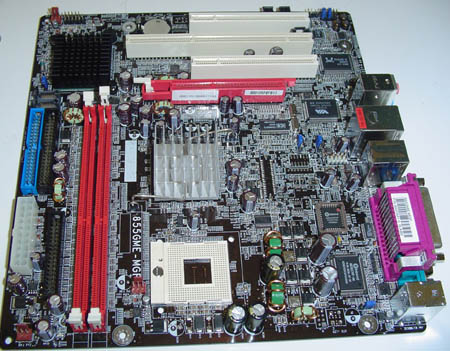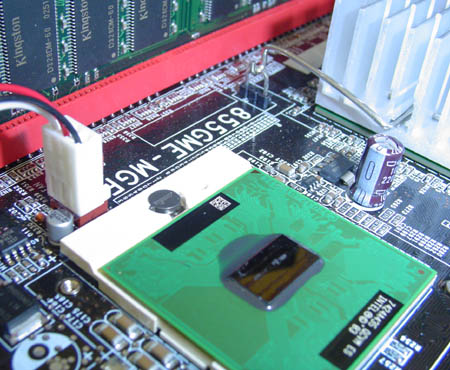Linux and the Desktop Pentium M: Uncommon Performance
by Kristopher Kubicki on December 24, 2004 12:00 PM EST- Posted in
- Linux
Motherboard Details
As we had briefly mentioned earlier, all desktop Dothan/Banias motherboards are all derived from blade configurations. The key term used when describing a blade is density; things tend to be a little smaller, and cost generally takes a back seat to thermal reduction and size reduction. Like a Beowulf cluster, there isn't a lot of need for top of the line, best of breed components so long as the components used are reliable, cool and small. After all, what is a 10% dip in performance on one blade if you can double the number of blades that sit in the same rack?All Pentium M blades run on Intel's notebook 855GME chipset. This chipset really doesn't differ from any other Dothan notebook chipset; DDR1, AGP/PCI, ICH5 and 400MHz front side bus. The 6300ESB southbridge provides a 64-bit PCI-X (not to be confused with PCI-Express) bus, which is generally dedicated to fiber optic networking.
For these sets of benchmarks, we selected the DFI 855GME-MFG motherboard but AOpen also sells a retail i855GME motherboard. Even though both motherboards come in MicroATX form factors and use relatively older bridges, these boards are very expensive - mostly due to the fact that they have no competition! At time of publication, our DFI 855GME-MFG cost a little over $250, which is a considerable amount to pay for a motherboard. On the other hand, if we buy a comparative top of the line Socket 775 motherboard, with all the trimmings, $250 isn't too much to spend.
DFI and AOpen do not differ much in design of their desktop Dothan motherboards, but DFI's board has a few extra amenities. A Realtek gigabit Ethernet port, six-channel VIA audio and Winbond Firewire are also standard on this motherboard - although, we had difficulties getting SUSE 9.1 and the Realtek 8110S Ethernet to play well together due to driver conflicts. For the duration of the analysis, we used an Intel Pro/1000+ Ethernet controller, but that should not affect our benchmarks. Our motherboard only supports a 4X AGP bus, but as we have seen in dozens of benchmarks before, that should hardly affect video performance, if at all.












47 Comments
View All Comments
Adul - Friday, December 24, 2004 - link
stephenbrooks "superlinearly" even a word? Though I do understand what you mean.KristopherKubicki - Friday, December 24, 2004 - link
abakshi: Intel roadmaps say only DDR1 for 915GL.Kristopher
stephenbrooks - Friday, December 24, 2004 - link
The Pentium M scales superlinearly with frequency in a few of the time vs. clock-speed benches (and I'm not talking about the 400->533 FSB improvement), which is pretty interesting. I wouldn't have expected a chip like this to get more efficient at _higher_ clocks.abakshi - Friday, December 24, 2004 - link
Well FSB533 is here, but 800 would be a more significant move with Dothan. A P-M with FSB800, even DDR400 let's say (rather than the DDR2 that should be supported by using a 915 northbridge), and higher clockspeeds - maybe about 2.4-2.6 Ghz - would be amazing.Linux performance will of course depend on other factors such as those mentioned in the article, but the performance under Windows of even the FSB400 2.0 Dothan is awesome -- when overclocked to 2.4Ghz, it's able to keep up with, and at times beat, the latest P4 Prescott and EE's, and A64's, for tasks like gaming:
http://www.gamepc.com/labs/view_content.asp?id=dot...
http://translate.google.com/translate?hl=en&sl...
Lonyo - Friday, December 24, 2004 - link
If Intel gave it a FSB and memory speed boost (ie: 533MHz or 800MHz FSB) and DDR533+, then Dothan could really be something.With Intels talk of dual core processors, a dual core Dothan, with its low heat output, would be awesome (but costly with 2MB of cache).
2x30w = 60w = less than Prescott.
It looks promising, if only Intel would bring it to the affordable desktop :(
VortigernRed - Friday, December 24, 2004 - link
"Although it holds up well against an Athlon 64 3200+,"Although the Dothan looks to be a superb chip you are certainly overstating its performance here, this is comment is WRT the Shake benchmarks and, effectively, the A64 3200 is twice as fast as the dothan. This would be like saying, for example, a R9800XT holds up well against an X800XT or an AXP2200+ holds up well against a A64 3800+ :-)
Also whilst the DDR400 does improve performance it can't help the Dothan where it is really far behind, the kernel compile benchmarks, for instance, it is still 3x slower than any of the other chips on the chart.
Dothan (or really its derivatives) have loads of potential to compete with the A64 on all fronts (Performance, power, heat, with Intels manufacturing, even cost) given enough effort by Intel (which I'm sure they are doing). I can hardly wait to see widespread adoption on the desktop and, frankly, to see the back of the P4. A desktop Celeron PM (1MB l2, lower FSB) could be the new overclocking king.
bersl2 - Friday, December 24, 2004 - link
You might want to ask on the GCC mailing lists (http://gcc.gnu.org/lists.html) about --march=pentium-m.